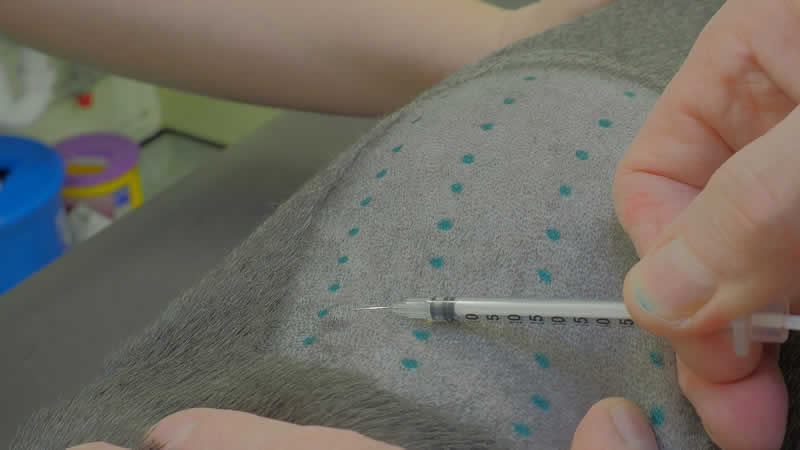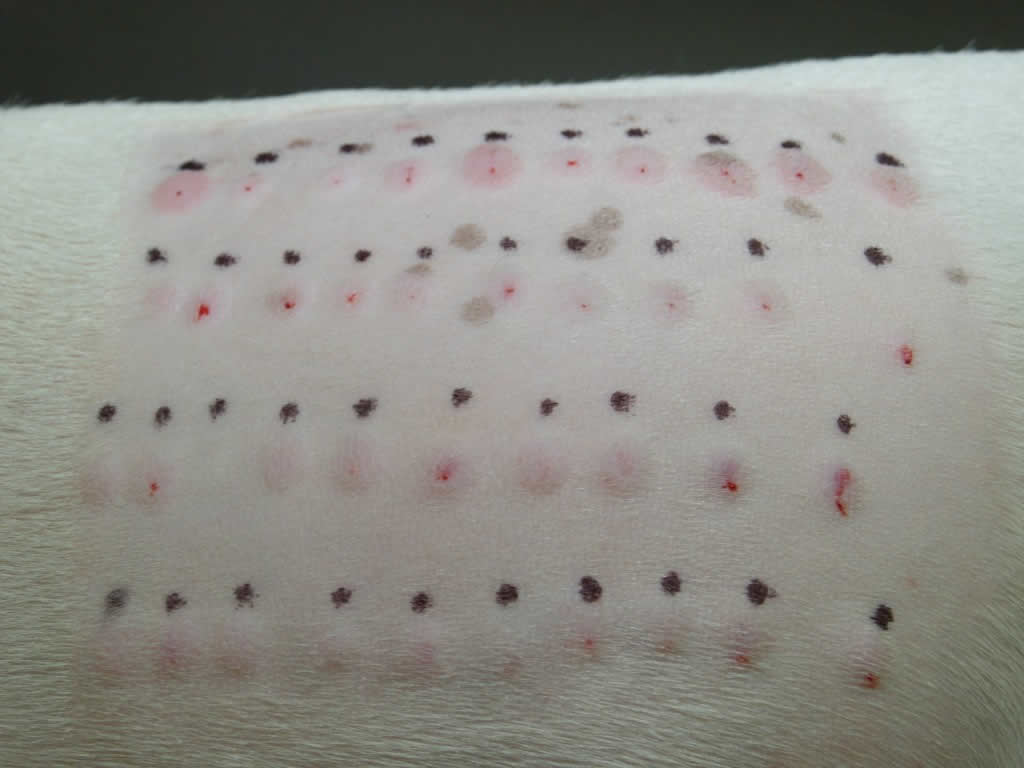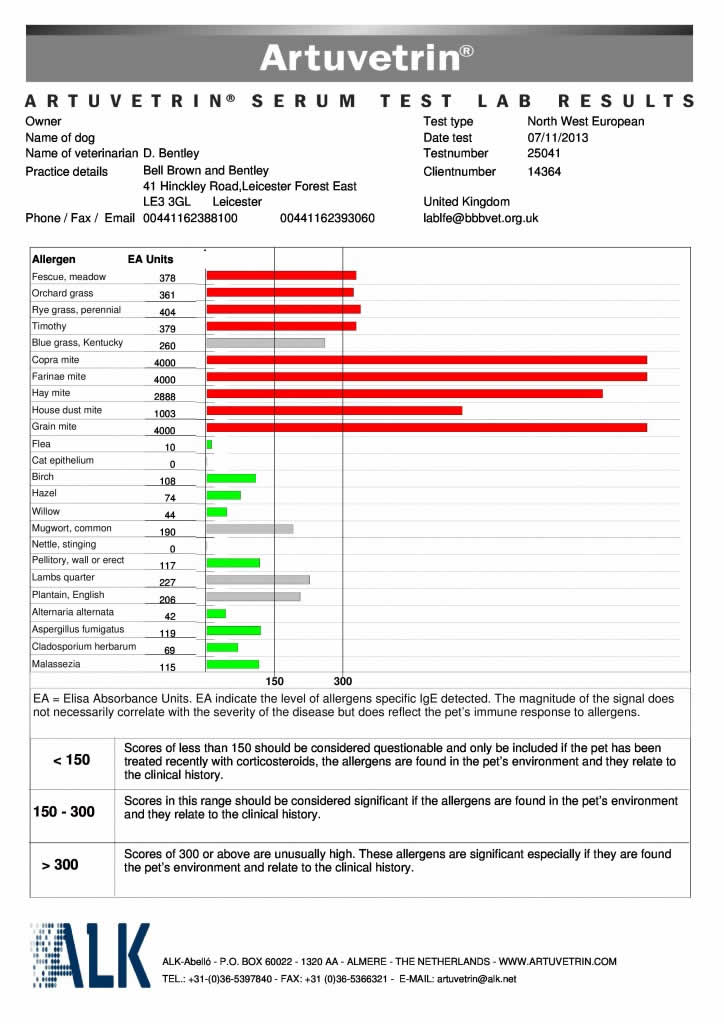Allergy Testing
When is allergy testing performed and what is its purpose?

Intradermal Skin Test
The diagnosis of atopy is based on history, consistent clinical signs and ruling out other causes of itchy skin and otitis externa.
Occasionally, non-atopic dogs and cats can have positive allergy test results – this is why it is vitally important that the correct diagnosis has been made first, before resorting to these tests, and why cases are best dealt with by a veterinary dermatologist.
Once a diagnosis of atopy is made, cat and dog allergy testing can be performed to discover what allergens are significant if we are to consider trying to reduce allergen exposure. This may help to reduce symptoms but is unlikely to abolish them completely.
Allergy testing is done primarily to decide upon which allergens to include in a treatment called Allergen-Specific Immunotherapy (ASIT).
Two methods of allergy testing can be used. Intradermal Skin Testing (IDST) is still considered the gold standard test amongst some veterinary dermatologists and there is also the choice of Serological Allergy Testing.
These tests measure allergy in different ways – IDST measures allergen specific antibody bound to cells in the skin called mast cells, which play an important part in the mechanism of itchy skin associated with atopy and serologicial allergy testing measures allergen specific allergic antibody in the bloodstream. From January 2023 , my allergen and immunotherapy supplier, Nextmune (formerly Artuvet) is offering a revolutionary new serological test that uses single allergen components (epitopes) at a molecular level, rather than the more crude allergen extracts, previously used in serological allergy tests. This new test has an increase in specificity and sensitivity, resulting in fewer false positives and giving information on cross-reactivities which will result in fewer allergens being put into immunotherapy vaccines, thus reducing the cost and hopefully increasing the efficacy of allergen-specific immunotherapy.
The allergens I use for my intradermal skin testing and also for making up Immunotherapy vaccines are supplied by Nextmune UK

Intradermal Skin test
For IDST, the test kit that I use contains 40 different indoor and outdoor allergens, including house dust mites, forage mites, grass, tree and weed pollens and moulds.
A very small quantity (0.05 ml) of each of the allergens and the control solutions is injected into the skin at various points – histamine is the positive control and the negative control is the solution that the allergens are contained in.
After 15-20 minutes, all the injection sites are assessed to see if there has been any swelling and redness of the skin. If a dog or cat is allergic to a particular substance, there will be an inflammatory response in the skin where it is injected and this will be seen as a swelling.
The size and degree of redness and swelling is compared with that of the control solutions, and this allows the animal’s allergies to be determined. The reactions we see in cats are much more muted that those seen in dogs and it takes a trained eye to see them – sometimes a fluorescent dye is injected intravenously and the injection sites examined with an ultraviolet light to evaluate the responses.
Blood samples can be taken to measure the amount of allergen-specific antibody there is in the bloodstream. Blood testing, until a few years ago, was not considered very reliable as many symptomless, non-atopic dogs could give positive results.
Results of ASIT based on these tests are nearly comparable with those based on IDST. They have the advantage that, although it is still recommended that animals are off steroids for at least 2 weeks before testing, results can still be obtained from cases that are or have only recently come off them.
If an animal has both IDST and Serological Allergy Testing performed, there can sometimes be a discrepancy with the results and some dermatologists now recommend doing both these tests together, as choosing allergens for ASIT from the positive results of both tests may result in a better response rate. Recent studies have shown that the half-life of allergen-specific antibodies has much shorter in serum than the fixed antibodies attached to mast cells in the skin, which is one of the reasons for a discrepancy with the results.
From January 2023, Nextmune UK (formely Artuvet) is offering a brand new, revolutionary type of serological allergy test that uses the actual molecules that the allergic antibody attaches to rather than crude allergen extracts. This new PAX ( Pet Allergy Explorer) test not only results in fewer false positives but can identify cross-reactivities and will result in us being able to formulate effective immunotherapy vaccines containing fewer allergens. There is a higher level of standardization of these molecular components than there is with crude allergen extracts and the reading of the test is more standardized and precise.
The new PAX Molecular Allergy Test is:-
- The first quantitative microarray IgE test specifically designed for animals
- Tests over 200 allergen extracts, compared to the 30-40 or so in the previous serology test or with Intradermal Skin Testing
- Better identification of cross-reactivities
- Fully automated process, higher level of standardisation, less human error/variability in interpretation
- With CCD blocking and 2 blocking efficacy detectors to weed out the false positives caused by Cross-reactive carbohydrate determinants (CCDs)in pollens.
For more information see the PAX allergy test bochure
If you’ve noticed skin or ear problems in your pet, it’s vital that you contact specialised veterinary professionals before symptoms worsen. To book an appointment with our small animal skin and ear experts, simply call us below


